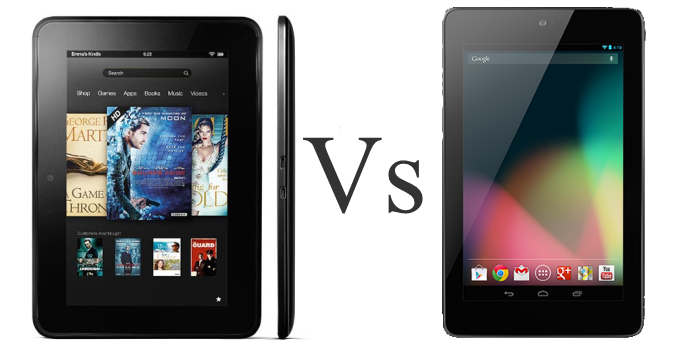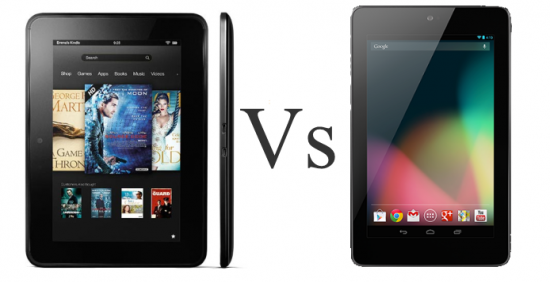The 7-inch Kindle Fire HD is priced exactly the same as the Google Nexus 7 here in the UK, which begs the question: which is better? Let’s take a look at how Amazon’s offering stands up against the current darling of Android tablets.
Screen
Nexus 7: LED backlit 7-inch IPS display, 1280 x 720 pixel resolution, 216ppi pixel density, Gorilla Glass
Kindle Fire HD: 7-inch IPS display, 1280 x 800 pixel resolution, 254ppi pixel density, Gorilla Glass, Polarising Filter and Anti-Glare
We were impressed with the Nexus 7’s screen, but on paper it looks as though Amazon will go one better with the Kindle Fire HD. Both have the same screen size and resolution (the Nexus 7 uses 80 rows of pixels for the three onscreen buttons), but the Kindle Fire HD looks to have a much sharper picture with the tech to reduce screen glare. We’ll wait to get our hands on one to see just how much better it is.
Processor
Nexus 7: 1.5GHz Quad-Core Nvidia Tegra 3
Kindle Fire HD: 1.2GHz Dual-Core
This category is where Amazon appears to have skimped to keep the costs down, whereas Google has plumped to shell out a fair bit to make the processor the key part. We’ve not had a chance to see how capable the dual-core chip in the Fire HD is, but we’re almost certain the Tegra 3 will blow it out of the water.
Battery
Nexus 7: 8 hours approx.
Kindle Fire HD: 11 hours approx.
The Nexus 7 is no slouch by any means in terms of battery life, and does admirably even with screen brightness on full and doing a spot of gaming. However, by the looks of things the Fire HD will offer more usage from a single charge, with “over 11 hours” advertised. With heavy usage this is likely to fall, and we’ll be testing both tablets together to see which offers more battery when Amazon’s launches.
Connectivity
Nexus 7: 3.5mm headphone jack, micro USB, Wi-Fi, Bluetooth, NFC,
Kindle Fire HD: 3.5mm headphone jack, micro USB, micro HDMI, dual antenna + dual-band Wi-Fi, Bluetooth
One of the major drawbacks of the Nexus 7 is its inability to output video to a TV; something the Kindle Fire HD can do thanks to a micro HDMI port. Amazon also claims that its Wi-Fi will be superior with fewer dropouts and a stronger signal, thanks to the use of dual antennas and dual Wi-Fi technology. As far as we’re aware the Nexus 7 has NFC as an advantage over Amazon’s offering, but it looks like the Kindle Fire HD wins on connectivity.
Software
Nexus 7: Android 4.1 Jelly Bean
Kindle Fire HD: Custom Amazon software based on Android 4.0 Ice Cream Sandwich
For those who want the latest software or prefer the ‘vanilla’ Android experience with no gimmicks or add-ons, the Nexus 7 is a clear winner. For the all-in-one package, Amazon’s tablet will give you easy access to apps, movie rentals, books and MP3 downloads with its Amazon-themed custom Android software. There’s no real clear winner here, unless you’re an Android purist.
Storage
Nexus 7: 8GB (£159) and 16GB (£199)
Kindle Fire HD: 16GB (£159) and 32GB (£199)
This area is where Amazon really delivers a sucker punch to Google. It’s priced both versions of the 7-inch Kindle Fire HD the same as the Nexus 7, but offers double the storage for the price in both cases. The Fire HD has no memory card slot, like the Nexus 7, but buyers will get plenty more storage for apps, photos, music and the like.
Audio
Nexus 7: Single speaker
Kindle Fire HD: Dual stereo speakers with Dolby Digital Audio
Another of Amazon’s bragging points is the audio quality. Google managed to squeeze a single speaker into the Nexus 7 – and we reckon it’s pretty darn good – but Amazon has two speakers for stereo sound, along with Dolby Digital Audio for ‘simulated surround sound’. We’ll need to wait to test them out side-by-side, but Amazon’s certainly sounds good on the first listen.
Dimensions
Nexus 7: 198.5mm x 120mm x 10.5 mm x 340g
Kindle Fire HD: 193 mm x 137 mm x 10.3 mm x 395g
With both tablets fitting the 7-inch category, our attention is turned to which is thinner and lighter as a general rule. The Nexus 7 is a fair bit lighter than the Kindle Fire HD, while the latter edges it in terms of thickness – just. We’re looking forward to finding out if the Kindle Fire’s extra weight gives it that ‘well built’ feel.
Initial Conclusion
Of course, the true comparison will come when we have the Kindle Fire HD in the flesh to compare with its rival. On paper, it looks as though Amazon has Google licked in terms of screen quality, sound and battery life. We can’t see the new Kindle tablet rivalling the Nexus for gameplay and speed though, as that Tegra 3 processor takes some beating.
For now, let us know which you think is better, and why on our comments below or via our @Gadget_Helpline Twitter page or Official Facebook group.

